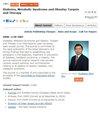A Prediction Model of Preeclampsia in Hyperglycemia Pregnancy
IF 2.8
3区 医学
Q3 ENDOCRINOLOGY & METABOLISM
Diabetes, Metabolic Syndrome and Obesity: Targets and Therapy
Pub Date : 2024-03-18
DOI:10.2147/dmso.s453204
引用次数: 0
Abstract
Purpose: To investigate the risk factors associated with preeclampsia in hyperglycemic pregnancies and develop a predictive model based on routine pregnancy care.Patients and Methods: The retrospective collection of clinical data was performed on 951 pregnant women with hyperglycemia, including those diagnosed with diabetes in pregnancy (DIP) and gestational diabetes mellitus (GDM), who delivered after 34 weeks of gestation at the Maternal and Child Health Hospital Affiliated to Anhui Medical University between January 2017 and December 2019. Observation indicators included liver and kidney function factors testing at 24– 29+6 weeks gestation, maternal age, and basal blood pressure. The indicators were screened univariately, and the “rms” package in R language was applied to explore the factors associated with PE in HIP pregnancy by stepwise regression. Multivariable logistic regression analysis was used to develop the prediction model. Based on the above results, a nomogram was constructed to predict the risk of PE occurrence in pregnant women with HIP. Then, the model was evaluated from three aspects: discrimination, calibration, and clinical utility. The internal validation was performed using the bootstrap procedure.
Results: Multivariate logistic regression analysis showed that cystatin C, uric acid, glutamyl aminotransferase, blood urea nitrogen, and basal systolic blood pressure as predictors of PE in pregnancy with HIP. The predictive model yielded an area under curve (AUC) value of 0.8031 (95% CI: 0.7383– 0.8679), with an optimal threshold of 0.0805, at which point the sensitivity was 0.8307 and specificity of 0.6604. Hosmer–Lemeshow test values were P = 0.3736, Brier score value was 0.0461. After 1000 Bootstrap re-samplings for internal validation, the AUC was 0.7886, the Brier score was 0.0478 and the predicted probability of the calibration curve was similar to the actual probability. A nomogram was constructed based on the above to visualize the model.
Conclusion: This study developed a model for predicting PE in pregnant women with HIP, achieving high predictive performance of PE risk through the information of routine pregnancy care.
Keywords: hyperglycemia in pregnancy, preeclampsia, prediction model, nomogram, internal validation
高血糖妊娠子痫前期的预测模型
目的:研究与高血糖孕妇子痫前期相关的风险因素,并根据常规孕期保健建立预测模型:回顾性收集2017年1月至2019年12月期间在安徽医科大学附属妇幼保健院妊娠34周后分娩的951例高血糖孕妇的临床资料,包括确诊为妊娠期糖尿病(DIP)和妊娠期糖尿病(GDM)的孕妇。观察指标包括孕24-29+6周肝肾功能因子检测、产妇年龄、基础血压等。对各项指标进行单变量筛选,应用R语言中的 "rms "软件包,通过逐步回归法探讨HIP妊娠PE的相关因素。采用多变量逻辑回归分析建立预测模型。根据上述结果,构建了预测 HIP 孕妇发生 PE 风险的提名图。然后,从判别、校准和临床实用性三个方面对模型进行了评估。采用引导程序进行了内部验证:多变量逻辑回归分析表明,胱抑素 C、尿酸、谷草转氨酶、血尿素氮和基础收缩压是妊娠合并 HIP 患者发生 PE 的预测因子。预测模型的曲线下面积(AUC)值为 0.8031(95% CI:0.7383- 0.8679),最佳阈值为 0.0805,此时灵敏度为 0.8307,特异性为 0.6604。Hosmer-Lemeshow 检验值为 P = 0.3736,Brier 评分值为 0.0461。经过 1000 次 Bootstrap 再抽样进行内部验证后,AUC 为 0.7886,Brier 评分为 0.0478,校准曲线的预测概率与实际概率相似。在此基础上构建了一个提名图,以直观地显示该模型:关键词:妊娠期高血糖;子痫前期;预测模型;提名图;内部验证
本文章由计算机程序翻译,如有差异,请以英文原文为准。
求助全文
约1分钟内获得全文
求助全文
来源期刊

Diabetes, Metabolic Syndrome and Obesity: Targets and Therapy
Pharmacology, Toxicology and Pharmaceutics-Pharmacology
CiteScore
5.90
自引率
6.10%
发文量
431
审稿时长
16 weeks
期刊介绍:
An international, peer-reviewed, open access, online journal. The journal is committed to the rapid publication of the latest laboratory and clinical findings in the fields of diabetes, metabolic syndrome and obesity research. Original research, review, case reports, hypothesis formation, expert opinion and commentaries are all considered for publication.
 求助内容:
求助内容: 应助结果提醒方式:
应助结果提醒方式:


